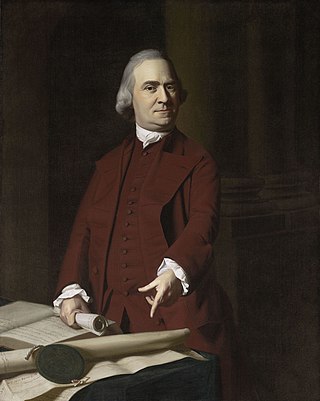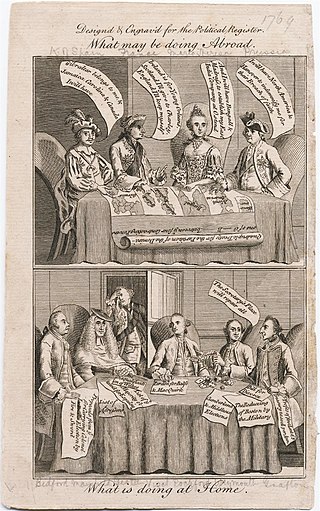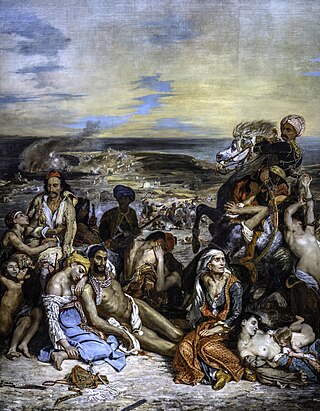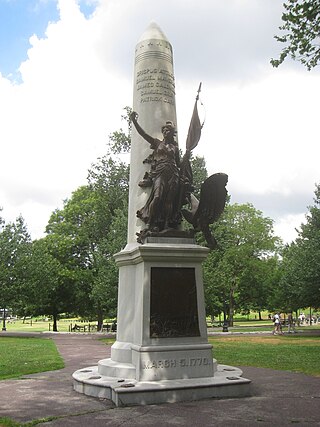Related Research Articles

The Boston Massacre was a confrontation in Boston on March 5, 1770, in which nine British soldiers shot several of a crowd of three or four hundred who were harassing them verbally and throwing various projectiles. The event was heavily publicized as "a massacre" by leading Patriots such as Paul Revere and Samuel Adams. British troops had been stationed in the Province of Massachusetts Bay since 1768 in order to support crown-appointed officials and to enforce unpopular Parliamentary legislation.

Crispus Attucks was an American whaler, sailor, and stevedore of African and Native American descent who is traditionally regarded as the first person killed in the Boston Massacre, and as a result the first American killed in the American Revolution.

The Massachusetts Supreme Judicial Court (SJC) is the highest court in the Commonwealth of Massachusetts. Although the claim is disputed by the Supreme Court of Pennsylvania, the SJC claims the distinction of being the oldest continuously functioning appellate court in the Americas, with a recognized history dating to the establishment of the Massachusetts Superior Court of Judicature in 1692 under the charter of the Province of Massachusetts Bay.

The Massachusetts Circular Letter was a statement written by Samuel Adams and James Otis Jr., and passed by the Massachusetts House of Representatives in February 1768 in response to the Townshend Acts. Reactions to the letter brought heightened tensions between the British Parliament and Massachusetts, and resulted in the military occupation of Boston by the British Army, which contributed to the coming of the American Revolution.

The 29th (Worcestershire) Regiment of Foot was an infantry regiment of the British Army, raised in 1694. Under the Childers Reforms it amalgamated with the 36th (Herefordshire) Regiment of Foot to become the 1st Battalion, the Worcestershire Regiment in 1881.
Captain Thomas Preston was a British military officer who served in Boston, Massachusetts. He commanded the troops involved in the Boston Massacre in 1770 and was tried for murder, but was acquitted. Historians have never settled whether he ordered his men to fire on the colonists. Preston was originally from Ireland; his people were among the Protestants settled there.

Josiah Quincy II was an American lawyer and patriot. He was a principal spokesman for the Sons of Liberty in Boston prior to the Revolution and was John Adams' co-counsel during the trials of Captain Thomas Preston and the soldiers involved in the Boston Massacre.

The Boston Gazette (1719–1798) was a newspaper published in Boston, in the British North American colonies. It was a weekly newspaper established by William Brooker, who was just appointed Postmaster of Boston, with its first issue released on December 21, 1719. The Boston Gazette is widely considered the most influential newspaper in early American history, especially in the years leading up to and into the American Revolution. In 1741 the Boston Gazette incorporated the New-England Weekly Journal, founded by Samuel Kneeland, and became the Boston-Gazette, or New-England Weekly Journal. Contributors included: Samuel Adams, Paul Revere, Phyllis Wheatley.

The Fifth of March is a 1993 novel about the Boston Massacre by historian and author Ann Rinaldi, who was also the author of other historical fiction novels, such as Girl in Blue and A Break with Charity.

The Battles of Lexington and Concord was the first major military campaign of the American Revolutionary War, resulting in an American victory and outpouring of militia support for the anti-British cause. The battles were fought on April 19, 1775, in Middlesex County, Province of Massachusetts Bay, within the towns of Lexington, Concord, Lincoln, Menotomy, and Cambridge. They marked the outbreak of armed conflict between the Kingdom of Great Britain and Patriot militias from America's thirteen colonies.
Christopher Seider was a boy who is considered to be the first American killed in the American Revolution. He was 11 years old when he was shot and killed by customs officer Ebenezer Richardson in Boston on February 22, 1770. His funeral became a major political event, with his death heightening tensions that erupted into the Boston Massacre on March 5, 1770.

John Adams is a 2008 American television miniseries chronicling U.S. Founding Father and president John Adams's political life and his role in the founding of the United States. The miniseries was directed by Tom Hooper and starred Paul Giamatti in the title role. Kirk Ellis wrote the screenplay based on the 2001 book John Adams. by David McCullough.

Samuel Adams was an American statesman, political philosopher, and a Founding Father of the United States. He was a politician in colonial Massachusetts, a leader of the movement that became the American Revolution, a signatory of the Declaration of Independence and other founding documents, and one of the architects of the principles of American republicanism that shaped the political culture of the United States. He was a second cousin to his fellow Founding Father, President John Adams. He founded the Sons of Liberty.
Hugh Montgomery may refer to:

The Massacre of St George's Fields occurred on 10 May 1768 when government soldiers opened fire on demonstrators that had gathered at St George's Fields, Southwark, in south London. The protest was against the imprisonment of the radical Member of Parliament John Wilkes for writing an article that severely criticised King George III. After the reading of the Riot Act telling the crowds to disperse within the hour, six or seven people were killed when fired on by troops. The incident in Britain entrenched the enduring idiom of "reading the Riot Act to someone", meaning "to reprimand severely", with the added sense of a stern warning. The phrase remains in common use in the English language.
John Fleeming or John Fleming was a printer, publisher and bookseller in Boston, Massachusetts, in the 18th century.
Private Hugh Montgomery was an Irish soldier who served in the 29th Regiment of Foot and was present at the Boston Massacre, for which he was found guilty of the manslaughter of one of the five fatalities, Crispus Attucks.

A massacre is an event of killing people who are not engaged in hostilities or are defenseless. It is generally used to describe a targeted killing of civilians en masse by an armed group or person.

The Boston Massacre Monument, also known as the Crispus Attucks Monument and Victory, is an outdoor bronze memorial by Adolph Robert Kraus, installed in Boston Common, in Boston, Massachusetts, United States.
Edward Garrick was an American wigmaker's apprentice and resident of Boston, Massachusetts, who is known for instigating the Boston Massacre on March 5, 1770.
References
- 1 2 3 4 5 6 Adams, John (5 March 1773). "The Summary of the Boston Massacre Trial". bostonmassacre.net. Retrieved 9 November 2010.
- ↑ Axelrod, Alan. The Real History of the American Revolution: A New Look at the Past (Sterling Publishing Company, 2007), p. 60.
- 1 2 Langguth, A. J. Patriots: The Men Who Started the American Revolution (Simon and Schuster, 1989), p. 138.
- ↑ Kidder, Frederic and Adams, John. History of the Boston Massacre, 5 March 1770 (J. Munsell, 1870), p. 254.
- ↑ Kidder, p. 276.
- ↑ Zobel, Hiller B. The Boston Massacre (New York: W.W. Norton & Company, 1970), pp. 274-275.
- ↑ "The Boston Massacre - 1770". americanrevwar.homestead.com. Retrieved 9 November 2010.
- ↑ Fleming, Thomas J. "Verdicts of History I: The Boston Massacre" Archived 20 February 2010 at the Wayback Machine . americanheritage.com. Retrieved 9 November 2010.